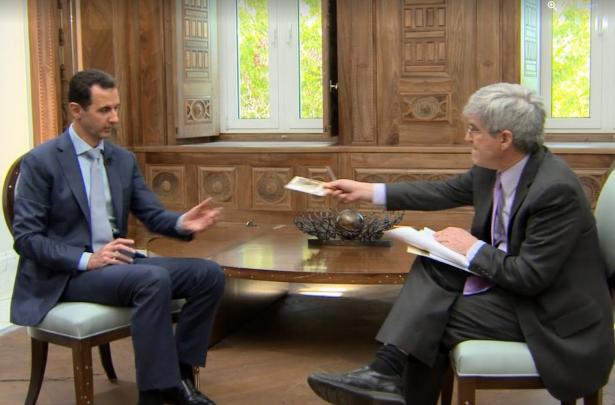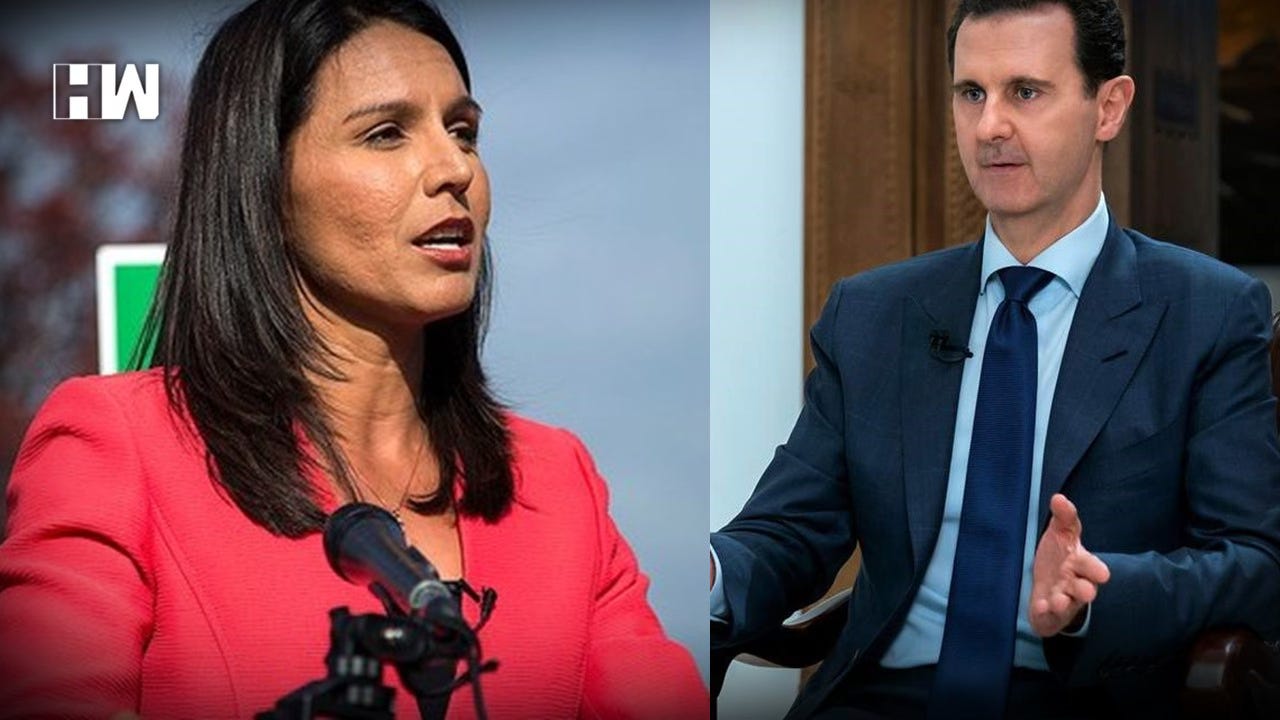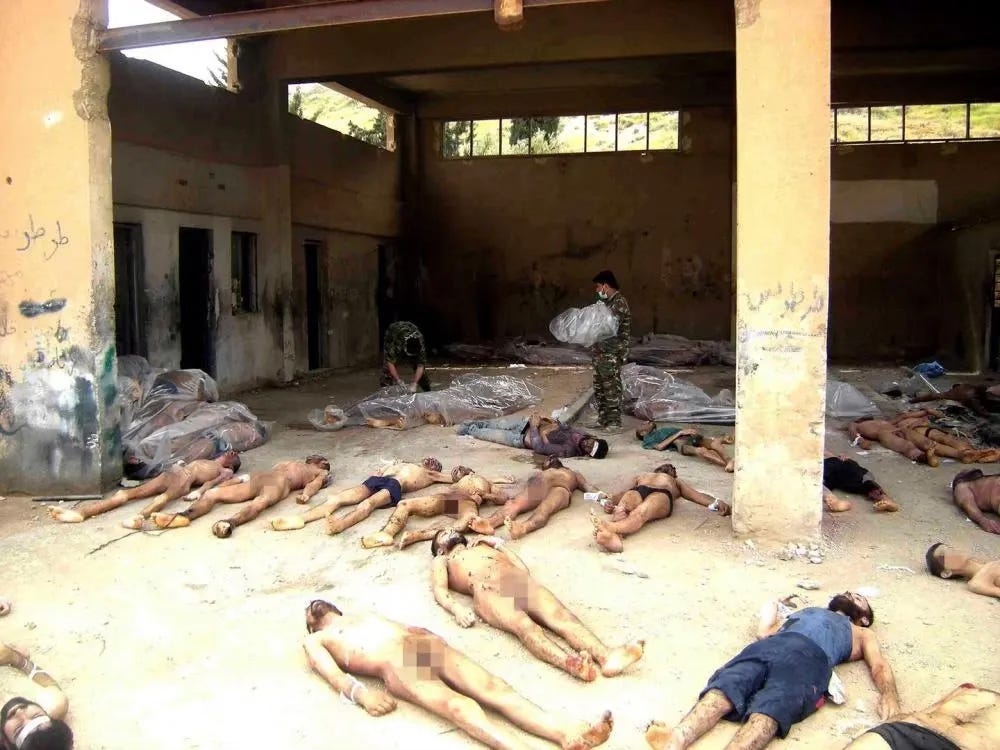In the early months of 2017, two Americans traveled to Syria where they met separately with that country’s dictator, Bashar Al-Assad.
One of them was Tulsi Gabbard, then a Hawaii Democratic congresswoman, now President-elect Trump’s pick to be Director of National Intelligence. Another American, arriving in Damascus less than two weeks later, was me.
It’s fair to say our meetings with Assad, and the messages we later relayed to the world about what was taking place inside his country, couldn’t have been more different.
Gabbard flew secretly to Syria in mid-January of that year— the first member of Congress to do so since 2011, when Syrian forces gunned down peaceful protestors and imprisoned thousands of others during the height of the Arab Spring. The ensuing conflict between anti-Assad forces and the Syrian military was unspeakably brutal — and became even more so in 2015 when Russia’s Vladimir Putin dispatched special forces and aircraft to bombard pockets of “rebel” resistance in towns like Aleppo.
But Gabbard was unmoved by the indiscriminate Russian bombing or Assad’s repeated use of chemical weapons against his own people. Her trip— privately funded by a Cleveland-based Arab American group sympathetic to Assad— turned into a propaganda coup for the Syrian regime. Gabbard had two meetings with Assad , revealing nothing (then or since) about what they actually said to each other.
These sessions with the dictator were, to say the least, controversial. “To say I’m disgusted would be an understatement,” said Republican congressman Adam Kinzinger on the House floor. “By meeting with the mass murderer of Syria, Bashar al-Assad, Tulsi Gabbard has legitimized his dictatorship and, in turn, legitimized his genocide against the Syrian people.”
Gabbard, for her part, defended herself, writing in a blog post (and in a later CNN interview ) that she would be ready to meet with anyone “if there’s a chance it can help bring about an end to this war.” She later said Assad is “not the enemy of the United States.”
But the real value to Assad from this trip is not what she said about him, but what she told the world about the Syrian conflict itself. She adopted wholesale the Syrian (and Russian) governments’ line that the main forces resisting Assad were not the Free Syrian Army and other rebel groups pledged to creating a democratic free Syria but Al Qaeda and ISIS terrorists — supported no less by the United States government. (Never mind that the U.S. military was engaged at the time in targeting and destroying the ISIS caliphate next door in Iraq.)
“There is no difference between ‘moderate’ rebels and al-Qaeda (al-Nusra) or ISIS—they are all the same,” Gabbard wrote in her blog post.
Gabbard swallowed Assad’s proaganda wholesale after her secret meeting with him in 2017. (HW-India)
Even more striking, she later released a three minute YouTube video about her trip, showing bombed out buildings as well as children in hospitals and maimed civilians with amputated legs, portraying them all as victims of the Syrian “terrorist” rebels. (Fact check: According to the UK based Syrian Network for Human Rights, as of 2022, 228,893 civilians had been killed in the country’s civil war— with more than 90 percent of these deaths caused by the Syrian military or its Russian allies.)
On her congressional website, she posted photos from the trip, including one of her meeting with Syrian religious leaders, each of whom, she wrote, called for “an end to foreign support of terrorists who are trying to rid Syria of its secular, pluralistic, free society.” (Fact check: Freedom House, which does annual rankings of the state of freedom in every country in the world, ranks Assad’s Syria close to the bottom of its list, below North Korea, China and Iran, calling it “one of the world’s most oppressive regimes” which “harshly suppresses freedom of speech and assembly” with “enforced disappearances, military trials and torture…rampant in government-controlled areas.”)
All of this was nothing new for Gabbard. Two years before her meeting with Assad, in 2015, Mouaz Moustafa, a Washington based anti-regime activist who serves as executive director of the Syrian Emergency Task Forces, took Gabbard and several other House members on a congressional trip to the Syrian-Turkish border. There, they met with displaced civilians who related how they were driven from their homes by relentless Syrian and Russian bombings. Much to Moustafa’s astonishment, Gabbard was openly skeptical. “How do you know it was Assad or the Russians who did the bombings?” she asked them. “How do you know it wasn’t ISIS?”
Moustafa could barely stop himself from blurting out the blindingly obvious: ISIS doesn’t have an Air Force! He came away clear-eyed about Gabbard’s world view. “She’s like the perfect product of RT propaganda,” he said.
Confronting Assad
I arrived in Damascus in early February, not long after Gabbard had left in late January. I was working for Yahoo News at the time and my trip was arranged by the Lebanese American brother of the director of the Cleveland based group that paid for Gabbard’s trip— only in my case, Yahoo News paid the brother as a fixer. If he was expecting another sympathetic report on Assad and his regime, however, he was soon to be sorely disappointed.
The trip was tense and at times nerve-wracking. Syria was a war zone and the Damascus airport was shut down. I and a Yahoo News cameraman had to fly to Beirut and travel by armed caravan through the Bekaa Valley to the Syrian border. Our fixer— with clear approvals from up high — had arranged for the Syrian military to provide us with safe passage, avoiding “rebel” areas, as we made our way to the capital. There, I checked into a five star Intercontinental hotel built in the days before Assad’s regime became an international pariah.
But on the morning of my scheduled interview, I was torn. My interest in in the Syrian civil war had been very much shaped by my reporting on the so-called Caesar photos— tens of thousands of gruesome photographs from inside Assad’s torture chambers showing rows of naked, bruised, burned and emaciated bodies, shocking images that were instantly reminiscent of those from Nazi concentration camps. (Indeed, they would later go on display in a special exhibit at the Holocaust Museum.) The photos had been taken by a regime photographer, codenamed Caesar, who was so sickened by what he was assigned to document— the torture and murder of Assad’s prisoners—that he defected and smuggled them out of the country in thumb drives concealed in his shoes. The late Senator John McCain told me he kept the photos on his desk and looked at them every day as a reminder of the horrors of the Syrian regime.
A brave Syrian took photos in Assad’s torture and murder dungeons and smuggled them to the West. This is just one of 50 thousand photos he brought.
Before I left on my trip, I contacted Moustafa and asked him for copies of some of the Caesar photos to take with me. I had watched past interviews of Assad and knew that, whenever confronted with questions about the grotesque excesses of his regime, he invariably responded: “Oh, do you have the evidence? Can you show me the evidence?” If I was going to ask him about the Caesar photos, I wanted to have the evidence to show him.
And then, I hesitated. What if Assad’s bodyguards frisked me when I showed up and found the photos? It would blow up the whole interview and my sole purpose for being there. I was genuinely uncertain whether it was worth the risk — until I logged onto the internet in the hotel’s business center and saw the lead story in that day’s New York Times.
“Amnesty Report Accuses Syria of Executing Thousands Since War Began,” read the headline. It told of a new report from the Amnesty International group that found that up to 13,000 people had been executed in mass hangings at Assad’s notorious Saydnaya military prison. The report further recounted how the detainees at Saydnaya — most of them jailed for participating in anti-government demonstrations — were subjected to severe and repeated beatings and then convicted while blindfolded in sham military trials that sometimes lasted only a few minutes.
In short, Assad’s brutality was very much international news on the day of my interview. I was now determined to advance the story. Not only would I question him about the Amnesty International report, but I could be the first journalist to confront him with the Caesar photos.
Vest Pocket Weapon
Throwing caution to the wind, I placed my copies of the photos in the inside pocket of my sports jacket — as well as another document I figured would come in handy—and hopped into my fixer’s car on the way to Assad’s presidential office.
It was all strange, of course. To my relief, I made it through security flawlessly— the Syrian security guards never inspected what was inside my jacket’s pocket. Assad, tall, awkward and somewhat herky-jerky in his movements—odd, I thought for a London-trai ophthalmologist— greeted me as I walked in, asking if we could have an informal chat before the interview began. He wanted to talk about the state of the American media, relating in the course of our somewhat stilted conversation how he liked to watch conservative Bill O’Reilly’s Fox News show and, no doubt for balance, the leftwing “Young Turks” YouTube show.
We then moved to a nearby office where, as a pre-condition for the interview, Syrian TV cameras would record it and provide us with a copy of the tape afterwards, repeatedly assuring us that no editorial content would be removed. I started the session slowly and respectfully, asking Assad whether he had had any communications with the new Trump administration in Washington (no, he hadn’t) and whether he saw a path to an improvement in U.S-Syria relations under the new president. (Sure, he said, as long as the U.S. works with his government, the Russians and the Iranians to fight the “terrorists” threatening his country.)
And when it came to the Syrian civil war, he offered his standard talking points, the same ones that had just been repeated to the world by Tulsa Gabbard, using virtually the identical language.
“Who supported the rebels and called them ‘moderate rebels’ while they became ISIS and Al-Nusra in Syria?” he said. “We didn’t. So it’s not our responsibility……Your country supported them.” (Fact check: the U.S. not only didn’t support Al-Nusra, it had designated it as a terrorist group. In the complexity of the war however, some U.S. aid to opposition groups indirectly benefited Al-Nusra.)
About halfway in, I started to press him about his human rights record. Things started to get testy. I brought up the Amnesty International Report which described the military prison at Saydnaya as a “human slaughterhouse.”
“What do you know about what’s going on in that prison?” I asked.
He dismissed the question as irrelevant. Why question him about human rights when the United States has “this close, very close relation” with Saudi Arabia?
“I’m not interviewing the King of Saudi Arabia right now,” I responded. “I’m interviewing you. I’m asking you about reports of human rights abuses in your prison, in your country.”
“Yeah, of course. You own the question. I own the answers. So that’s my answer,” Assad, replied with a nervous laugh.
“The United States is in no position to talk about human rights,” he said. “Since the Vietnam War til this moment, they killed millions of civilians. You don’t talk about the 1.5 million in Iraq without any assignment by the Security Council” authorizing the invasion of that country, he added. As for Amnesty International, “it’s always biased and politicized.”
I pointed out that the report was based on interviews with former prison officials and doctors as well as three former Syrian judges who related that the mass hangings were approved by either the Syrian Minister of Defense or Army Chief of Staff— both of whom had been “deputized to act on behalf of President Bashar al-Assad.”
“It means nothing,” he replied.
“Nothing?”
“No. When you need to make a report, you need evidence, concrete evidence.” He then suggested that the witnesses interviewed by Amnesty had been paid for their report. “You can forge anything these days.”
Photo Finish
It was now time to move onto the Caesar photos, questions he was likely not expecting. I told him that a Syrian woman had just filed suit in Spain against nine senior Syrian government and intelligence officials alleging her brother had disappeared in one of his prisons— and she was backing up the claims of abuse by citing the Caesar photos, one of which showed her beaten brother.
“Have you seen the photos? I asked him.
“No, I didn’t. Do you have a photo?”
“I do have the photos.”
“Can you show it to me?”
“Yes, I’d be happy to,” I replied, reaching into my inside jacket pocket and handing them to him. “Here.”
And just as I did, the lights went out, the cameras went off and the room was plunged into darkness.
It was a surreal moment. I was sitting there face to face with Assad in the dark while he was holding in his hands photos of his tortured victims, not saying a word, barely giving them a glance. In a moment, his press aide rushed into the room and announced that a fuse had blown and they were working on fixing it. Given the timing, I was, to say the least, skeptical. In a back room somewhere in a presidential suite, I figured nervous aides were no doubt debating whether to allow the interview to continue.
But after a few minutes, they decided they would— likely concluding, quite correctly, that if they cut off the interview at that moment it would be the principal focus of my story. The lights came back on and the interview continued. (You can watch the entire exchange here with the interregnum in darkness cut out in the edit room by Syrian TV producers.)
“Have you verified” the photos? Assad demanded. “You cannot mention such a picture without verifying who are those and where and everything about it.” The photos were no doubt doctored, he argued.
I pointed out that the U.S. State Department had given 242 of the photos to the FBI Crime Lab for analysis. I then whipped out the other document I had taken with me in my jacket: the FBI report on the Caesar photos. I read it to him. “The bodies and the scenes depicted exhibit no artifacts or inconsistencies that would indicate they have been manipulated. As a result of the above observations, all of these 242 images appear to depict real people and events.”
“Who said that?” “The FBI. Have you seen the report?” I handed it to him.
“Whether, if the FBI says something, it’s not some—something it’s not evidence for anyone, especially for us … It’s just propaganda. It’s just fake news.”
And with that, Assad gave me my lead. The dictator of Syria was using a phrase—“fake news”—that had been coined on the campaign trail by the now U.S. president. It was a new and lethal American export, a gift to authoritarians around the world looking for a way to dismiss and ridicule inconvenient truths.
And Assad, no doubt emboldened by the p.r. boost he had just gotten from his new friend, the congresswoman from Hawaii, was happy to join the chorus.
Michael Isikoff is an award-winning investigative journalist and best-selling author who has reported for The Washington Post, Newsweek, NBC News and Yahoo News.
SpyTalk is a reader-supported publication. To receive new posts and support our work, consider becoming a free or paid subscriber. You can take out a free trial here.




Spread the word